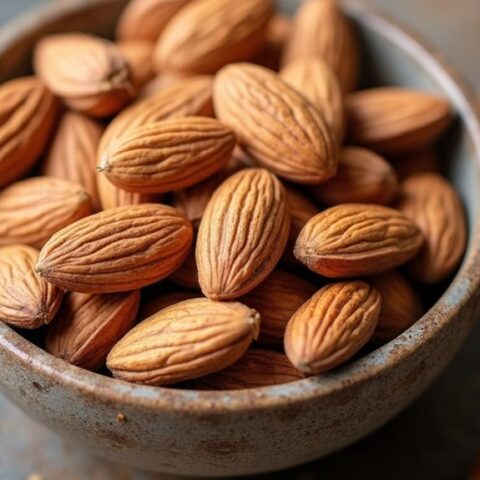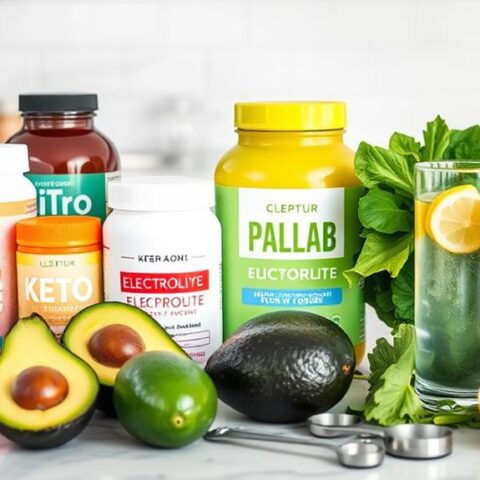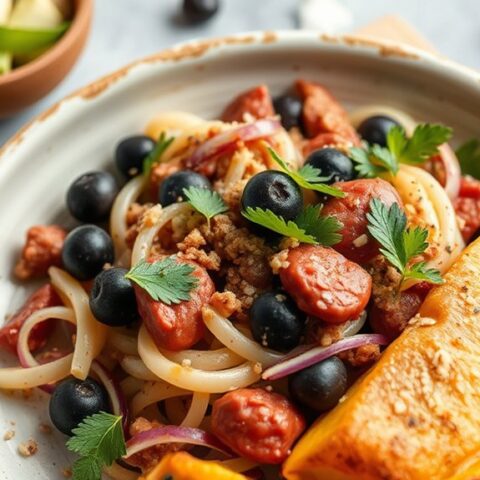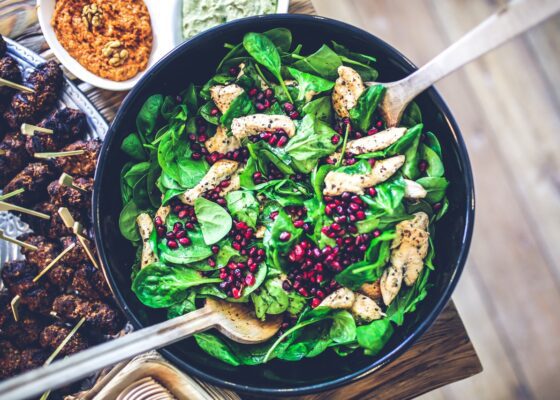
Creating a low-carb sourdough starter begins with combining 75g of lupin flour and 200g of distilled water in a tall jar with loose lid coverage. The mixture requires daily feedings at consistent 24-hour intervals, maintaining temperatures between 70-85°F (21-29°C). Signs of healthy fermentation include active bubbles and a sweet-vinegary aroma developing over two weeks. Proper measurement, feeding schedules, and environmental conditions form the foundation for successful low-carb sourdough bread making.
Key Takeaways
- Mix 75g of lupin flour with 200g distilled water in a tall jar, keeping the lid loose for proper airflow.
- Feed the starter daily with equal amounts of flour and water while maintaining temperatures between 70-85°F (21-29°C).
- Look for consistent doubling in size within 4-6 hours after feeding and a pleasant, tangy aroma.
- Monitor fermentation progress through bubble formation and wait for aroma to evolve from sulfuric to sweet-vinegary.
- Place starter in an unheated oven with the light on for warmth and check regularly for healthy fermentation signs.
Understanding Low Carb Sourdough Fundamentals
The art of creating low carb sourdough bread represents a significant departure from traditional breadmaking, combining time-honored fermentation techniques with modern dietary needs. This innovative approach substitutes conventional wheat flour with almond and coconut flours, drastically reducing carbohydrate content while maintaining bread's familiar characteristics. The fermentation process remains central to low carb sourdough production, as wild yeast and beneficial bacteria work to break down carbohydrates and enhance digestibility. An essential ingredient, psyllium husk powder, provides crucial structure and moisture retention, helping achieve an authentic bread texture despite the absence of gluten. Success depends on maintaining proper hydration levels and allowing adequate fermentation time, with bakers needing to adjust these factors based on their specific environment and ingredients to achieve optimal outcomes. Using coconut oil can enhance the nutritional quality of low carb sourdough, offering antibacterial properties and supporting energy production.
Essential Equipment and Ingredients
Successful low-carb sourdough bread making begins with gathering precise equipment and carefully selected ingredients, forming the foundation for consistent results. A digital kitchen scale that measures in grams guarantees accurate proportions, while a one-quart mason jar provides an ideal vessel for maintaining the sourdough starter.
The primary ingredient for a low-carb sourdough starter is lupin flour, requiring approximately 3 pounds for long-term maintenance. This alternative flour combines with distilled or de-chlorinated water in a specific ratio of 75g flour to 200g water during feeding. Incorporating magnesium supplements can support muscle function and reduce fatigue, which is beneficial during the adaptation period of a low-carb diet.
Additional essential ingredients include almond flour and psyllium husk powder, which work together with the mature starter to create bread with proper texture while maintaining minimal net carbs. The starter requires up to 14 days to reach full maturity, developing through distinct aromatic stages.
Selecting the Right Alternative Flours
Creating successful low carb sourdough bread relies on strategic combinations of grain-free flours, with almond and coconut flours serving as primary foundations. Experienced bakers often pair these base flours with binding agents like psyllium husk powder or flax meal to achieve ideal texture and structure. The incorporation of protein-rich alternatives such as lupin flour can further enhance the bread's nutritional profile while maintaining the desired low carb count. To ensure the best results, it's essential to consider the unique properties of low-carb flours, which may require adjustments in liquid and cooking times for optimal baking outcomes.
Grain-Free Flour Combinations
Mastering grain-free flour combinations stands as an important foundation for creating successful low-carb sourdough bread.
The strategic blend of almond flour and coconut flour, enhanced with psyllium husk powder, creates an ideal base for keto-friendly bread that maintains traditional texture and structure.
- Almond flour provides a protein-rich foundation with only 3g of carbs per serving.
- Coconut flour contributes essential fiber while improving bread structure.
- Psyllium husk acts as a vital binding agent and moisture retainer.
- Flax meal offers additional binding properties plus beneficial omega-3s.
- A one-to-one ratio of almond to coconut flour serves as an effective starting point.
These flour combinations can be adjusted based on desired texture and taste preferences, while maintaining the low-carb profile necessary for keto-friendly sourdough bread.
Nut Flour Success Strategies
The strategic selection of alternative flours forms the cornerstone of successful low-carb sourdough bread making, with each flour type contributing unique properties to the final product. Almond flour stands out as the primary choice, offering minimal carbohydrates while providing a sturdy base for the bread structure.
When incorporating psyllium husk powder, bakers achieve the essential elasticity and binding properties traditionally found in gluten-containing flours.
For ideal results, combining different nut flours requires careful attention to moisture ratios. Coconut flour, while beneficial for texture, demands additional liquid components to prevent a dry end product.
Experimentation with hydration levels becomes vital when working with these alternative ingredients, as proper moisture balance directly impacts the bread's rise and final texture in low carb sourdough recipes.
Creating Your First Low Carb Starter
Making your first low-carb sourdough starter begins with a straightforward combination of specialty flour and water, setting the foundation for a thriving fermentation process. The development requires consistent attention and precise measurements to establish a healthy culture.
Key steps for maintaining your starter:
- Combine 75g of low-carb flour with 200g of distilled water in a tall jar.
- Keep the lid loosely secured to allow proper airflow.
- Feed the starter daily with equal parts flour and water.
- Monitor the aroma as it shifts from sulfuric to sweet-vinegary.
- Consider incorporating oat fiber to reduce costs while maintaining quality.
The fermentation process takes approximately two weeks to fully mature, after which the starter can be maintained either at room temperature with daily feedings or refrigerated for weekly care.
Feeding and Maintaining Your Starter
Maintaining a low-carb sourdough starter requires consistent daily feedings, with ideal feeding times occurring every 24 hours at room temperature.
The starter thrives best when kept between 70-85°F (21-29°C), which promotes healthy bacterial growth and fermentation activity.
To establish a reliable feeding schedule, bakers should feed their starter at the same time each day, discarding a portion and adding fresh low-carb flour and water in equal ratios to maintain the culture's importance.
Daily Starter Feeding Schedule
Successfully maintaining a low-carb sourdough starter requires three key practices: consistent daily feedings, accurate measurements, and careful temperature monitoring. A proper feeding routine involves using a digital kitchen scale to measure ingredients precisely, following a 1:2 ratio of starter to water, combined with low-carb flour.
- Begin with room temperature fermentation for 24 hours
- Measure ingredients precisely using a digital scale
- Feed daily if kept at room temperature, weekly if refrigerated
- Monitor the starter's aroma development
- Adjust feeding frequency based on activity level
The starter's development can be tracked through its changing aroma, evolving from initial sulfuric notes to a pleasant, tangy scent within two weeks.
This transformation indicates the starter is building the necessary microbial community for successful fermentation and is becoming ready for baking.
Optimal Temperature For Growth
The environment's temperature plays a fundamental role in developing a thriving low-carb sourdough starter, complementing proper feeding practices. For ideal temperature conditions, maintain your starter between 70°F and 85°F (21°C to 29°C), which creates an advantageous environment for beneficial yeast and bacteria growth.
Temperature management directly impacts fermentation rates and starter activity. While warmer temperatures within the recommended range accelerate fermentation and enhance flavor development, temperatures below this range can considerably slow down microbial activity.
It's essential to avoid temperatures exceeding 85°F (29°C), as these conditions may promote unwanted bacterial growth that could compromise your starter's health. Regular temperature monitoring and strategic placement of your sourdough starter in your kitchen will help maintain these ideal conditions.
Signs of a Healthy Fermentation
Recognizing the signs of healthy fermentation in sourdough starter empowers bakers to create successful low-carb bread. A properly maintained starter exhibits specific characteristics that indicate ideal wild yeast activity and bacterial growth, essential for achieving the desired bread texture and flavor profile.
- Active bubbles throughout the mixture, signaling robust fermentation
- Pleasant, tangy aroma that evolves from sulfurous to sweet-vinegary
- Consistent doubling in size within 4-6 hours post-feeding
- Sponge-like texture with regular, predictable rise patterns
- Stable performance when maintained at 70-85°F
These indicators help bakers determine when their starter is ready for baking.
Regular monitoring of these signs guarantees the fermentation process remains on track, ultimately leading to better-quality low-carb sourdough bread with proper structure and taste.
Troubleshooting Common Starter Issues
When sourdough starters exhibit issues, bakers must identify and address problems promptly to maintain healthy fermentation. Common indicators of starter problems include unusual odors, such as rotten eggs, which typically signal insufficient oxygen, while lack of bubbling may indicate an underfed culture or suboptimal temperature conditions.
A well-maintained sourdough starter should have consistent texture and activity. If the mixture becomes too liquid, adjusting the flour-to-water ratio can help achieve proper consistency.
The presence of hooch, a liquid layer on top, suggests the starter needs feeding. For starters that demonstrate weak fermentation power, extending bulk fermentation time and ensuring proper feeding schedules can improve performance.
Maintaining temperatures between 70-85°F and providing adequate ventilation are essential steps in resolving these common issues.
Measuring and Testing Starter Activity
Evaluating sourdough starter activity involves monitoring key visual indicators, such as the presence of consistent bubbles throughout the mixture and a noticeable increase in volume over time.
The starter's peak performance can be verified by tracking its ability to double in size within 4-6 hours after feeding at room temperature, particularly when maintained between 70-85°F.
A simple yet effective way to confirm starter readiness is the float test, where a small portion dropped in water should float, indicating sufficient fermentation activity for successful low-carb bread making.
Starter Bubbling Activity Signs
Understanding the signs of a healthy sourdough starter is essential for successful low-carb bread making. A well-maintained starter exhibits specific indicators of active fermentation and ideal health, which directly impact the final bread quality.
- Consistent bubbling throughout the mixture within 4-8 hours after feeding
- A sweet, tangy aroma instead of unpleasant or rotten smells
- Successful float test results when a spoonful is placed in water
- Regular bubbling and rising pattern after each feeding, typically by day 5-7
- Doubling in size within 4-6 hours of feeding
These visual and olfactory cues help bakers determine when their sourdough starter has reached peak fermentation activity.
Monitoring these signs guarantees the starter contains sufficient wild yeast and beneficial bacteria for proper bread leavening, resulting in better texture and flavor development.
Peak Rise Testing Points
Testing a sourdough starter's peak rise requires precise measurement techniques and careful observation to determine its readiness for baking. Monitoring specific indicators helps assess the starter's importance and fermentation progress, ensuring ideal results in low-carb bread making.
| Test Method | Key Indicators |
|---|---|
| Volume Check | Doubles in 4-6 hours |
| Float Test | Small portion floats in water |
| Aroma Assessment | Pleasant, mild tang |
| Bubble Formation | Visible air pockets |
| Temperature Control | Maintain 70-85°F |
To evaluate peak rise effectively, bakers should track the starter's volume increase throughout the day, looking for a doubling within 4-6 hours post-feeding. The float test provides a quick way to confirm readiness, while consistent bubble formation and a proper tangy aroma indicate healthy fermentation activity.
Starter Float Test Guide
The float test serves as a reliable indicator of a sourdough starter's readiness for baking, particularly essential when crafting low-carb variations. This straightforward method involves placing a small portion of the starter in water to assess its fermentation activity and gas production levels.
To perform an effective sourdough float test:
- Drop a teaspoon of active starter into a glass of room temperature water
- Observe whether the starter floats or sinks immediately
- Test the starter 4-6 hours after feeding for best results
- Verify the starter is at its peak rise before testing
- Repeat the test if the starter sinks, allowing more fermentation time
A floating starter indicates proper gas development and readiness for baking, while a sinking starter typically requires additional fermentation time or feeding adjustments to achieve best activity levels.
Optimal Temperature and Environment
Because successful fermentation depends heavily on environmental conditions, maintaining ideal temperature and humidity is essential for developing a thriving low carb sourdough starter.
The best temperature range of 70-85°F (21-29°C) promotes active fermentation by supporting both yeast and bacterial growth.
Creating the right environment can be achieved by placing the starter in an unheated oven with the light on, which provides consistent warmth.
Monitoring humidity levels is vital, as excessive moisture can lead to mold growth, while insufficient humidity may cause the starter to dry out.
Temperature fluctuations outside the ideal range can greatly impact starter performance, with cooler temperatures slowing fermentation and warmer temperatures potentially encouraging harmful bacteria.
Regular monitoring for bubbles and a tangy aroma indicates proper environmental conditions are being maintained.
Converting Traditional Recipes
Successfully converting traditional sourdough recipes into low-carb versions requires careful ingredient substitutions and ratio adjustments to maintain the bread's characteristic texture and flavor.
Creating delicious low-carb sourdough means mastering the art of substitutions while preserving the bread's authentic qualities and taste profile.
When adapting recipes, bakers must consider the unique properties of alternative flours and their interaction with water, while maintaining proper fermentation times for ideal results.
- Replace wheat flour with almond flour or an almond-coconut flour blend
- Add psyllium husk powder (1 tablespoon per cup of flour) for proper structure
- Use a low-carb sourdough starter made with lupin flour for fermentation
- Adjust liquid content gradually, as low-carb flours absorb moisture differently
- Allow for extended fermentation times to develop flavor and improve texture
These modifications help create a low-carb bread that closely resembles traditional sourdough while maintaining considerably reduced carbohydrate content.
Best Storage Practices
Proper storage of low-carb sourdough bread is essential for maintaining its freshness and extending its shelf life.
For fresh storage, bakers should keep their bread in an airtight container or wrapped tightly at room temperature, where it will remain good for up to five days.
Those seeking longer-term preservation can freeze pre-sliced portions in sealed containers, allowing the bread to stay fresh for up to a month while maintaining easy access to individual servings.
Fresh Storage Methods
The longevity and quality of low-carb sourdough bread depend heavily on appropriate storage techniques. Proper storage methods guarantee peak freshness and prevent premature spoilage. For immediate consumption, maintain sourdough bread at room temperature in an airtight container for up to two days.
- Store in a cool, dry location away from direct sunlight
- Use airtight containers to prevent moisture accumulation
- Keep at room temperature for 1-2 days maximum
- Refrigerate for extended storage up to 5 days
- Place parchment paper between slices when storing
These storage methods help preserve the bread's texture and taste while preventing mold growth.
When implementing these practices, the bread maintains its artisanal qualities longer, allowing for extended enjoyment of this low-carb alternative to traditional sourdough.
Freezing For Long-Term
Preserving low-carb sourdough bread through freezing represents an effective long-term storage solution that extends shelf life up to one month while maintaining the bread's distinctive qualities.
Before initiating the freeze storage process, allow the bread to cool completely to prevent condensation and texture degradation.
Pre-slicing the sourdough bread facilitates convenient portion control and prevents slices from adhering together during storage.
Wrap the sliced bread securely in plastic wrap or aluminum foil, then place it in an airtight container or freezer bag.
Label the package with the freezing date to monitor freshness.
When ready to enjoy, toast or reheat the frozen slices directly from the freezer, eliminating the need for thawing and ensuring ideal texture retention.
Enhancing Flavor and Texture
Although creating a low carb sourdough bread presents unique challenges, bakers can enhance both flavor and texture through several proven techniques. A long fermentation process develops sourdough flavor while making the bread easier to digest. The addition of sauerkraut juice or apple cider vinegar introduces beneficial probiotics and enhances tanginess.
- Combine almond and coconut flours with psyllium husk powder for ideal texture
- Add garlic powder or dried rosemary to create depth and complexity
- Incorporate various nuts or seeds for unique flavor profiles
- Use sauerkraut juice or apple cider vinegar to boost tanginess
- Allow extended fermentation time to develop robust flavors
When sweetening your low-carb recipes, consider using keto-friendly sweeteners like stevia or erythritol to maintain a low-carb profile without sacrificing sweetness.
These modifications help achieve a more authentic sourdough experience while maintaining the bread's low-carb profile, resulting in a satisfying alternative to traditional wheat-based sourdough.
Managing Carb Content
Successfully managing carb content in sourdough bread requires careful selection of alternative flours and precise measurement of ingredients throughout the baking process. Traditional sourdough's high carb content of 16.1g per slice can be considerably reduced by incorporating low-carb flours like almond flour, which contains only 3g of carbs per serving. To maintain structural integrity while minimizing net carbs, bakers should combine these alternative flours with psyllium husk powder in their sourdough recipe. Additional ingredients such as flax meal, egg whites, and buttermilk can further enhance the bread's texture while keeping carbohydrates low. Regular monitoring of ingredient proportions and careful tracking of total carbohydrates guarantees the final product aligns with specific dietary requirements, making it suitable for those following low-carb eating plans. For those looking to explore keto-friendly options, Shirataki noodles offer a low-carb, gluten-free alternative that can complement your meal planning.
Scaling Your Recipe
When scaling a low carb sourdough bread recipe, bakers must carefully adjust ingredient quantities while maintaining precise ratios to guarantee consistent results across different batch sizes.
The amount of sourdough starter should be adjusted to 10-20% of the total flour weight to guarantee proper fermentation time and ideal rise.
- Calculate dry-to-wet ingredient ratios accurately to maintain proper hydration
- Use multiple fermentation containers for larger batch sizes
- Adjust fermentation time upward for increased dough volume
- Monitor internal temperature to guarantee complete baking (200°F)
- Scale starter proportionally to total flour weight
Larger batches typically require additional fermentation time and may need adjusted baking durations.
Bakers should carefully monitor the dough's progress and use appropriate-sized containers to accommodate the increased volume while maintaining proper fermentation conditions.
Frequently Asked Questions
What Is the Biggest Mistake You Can Make With Your Sourdough Starter?
The biggest mistake is neglecting proper starter maintenance through irregular feeding schedules. This disrupts ideal hydration levels and weakens the culture, resulting in an inactive starter incapable of proper fermentation.
How to Reduce Carbs in Sourdough Bread?
Using alternative flours like almond or coconut, incorporating carb substitutes such as psyllium husk, and extending yeast fermentation time effectively reduces carbohydrate content in sourdough bread while maintaining texture.
What Are Three Top Tips When Making Sourdough Starter?
Maintain consistent hydration levels between flour and water mixtures. Select appropriate flour types, focusing on quality ingredients. Follow a strict daily feeding schedule to guarantee starter remains active and healthy.
Can Sourdough Be Low Carb?
Traditional sourdough can be adapted to be low-carb using alternative flours. The fermentation effects reduce carbohydrates while maintaining sourdough health benefits through the use of almond flour and coconut flour.
Conclusion
Making low carb sourdough bread requires patience, precision, and consistent attention to detail. By carefully selecting alternative flours, maintaining proper starter health, and following recommended storage practices, bakers can create delicious bread with considerably reduced carbohydrates. While the process may take longer than traditional sourdough, the results offer a satisfying option for health-conscious bread enthusiasts who don't want to compromise on taste or texture.









No Comments